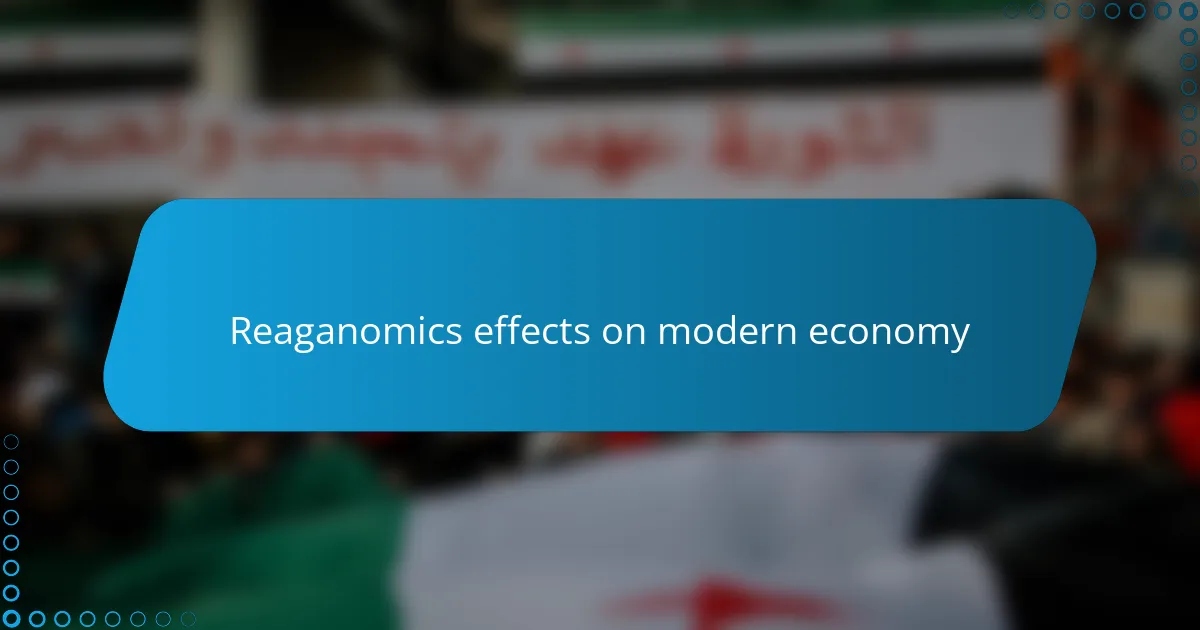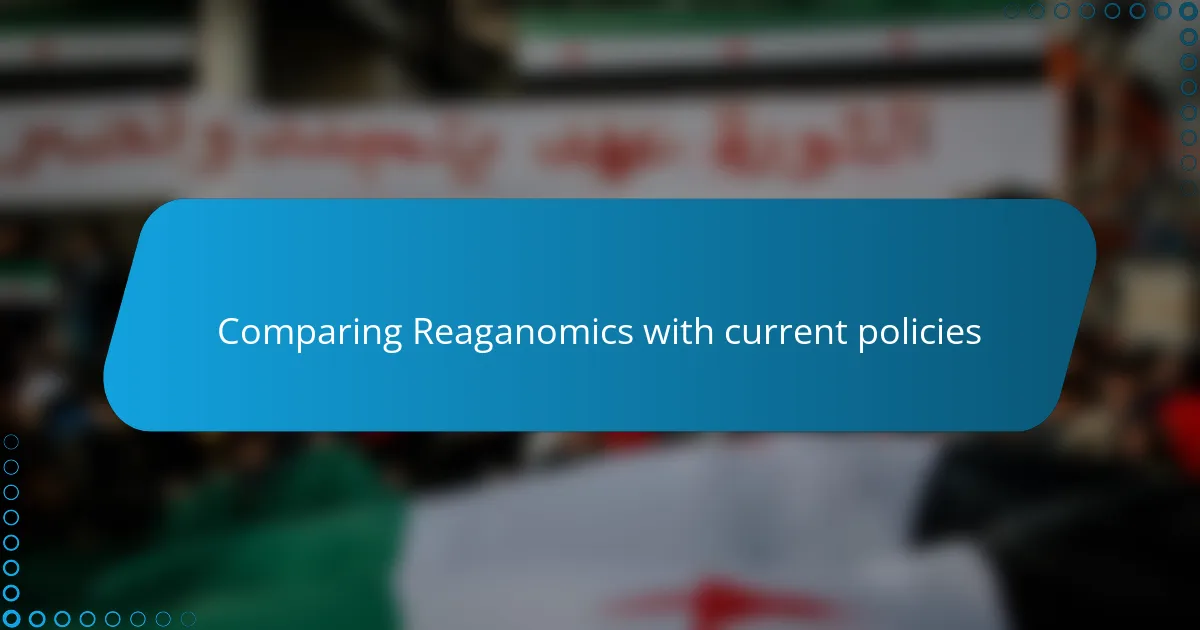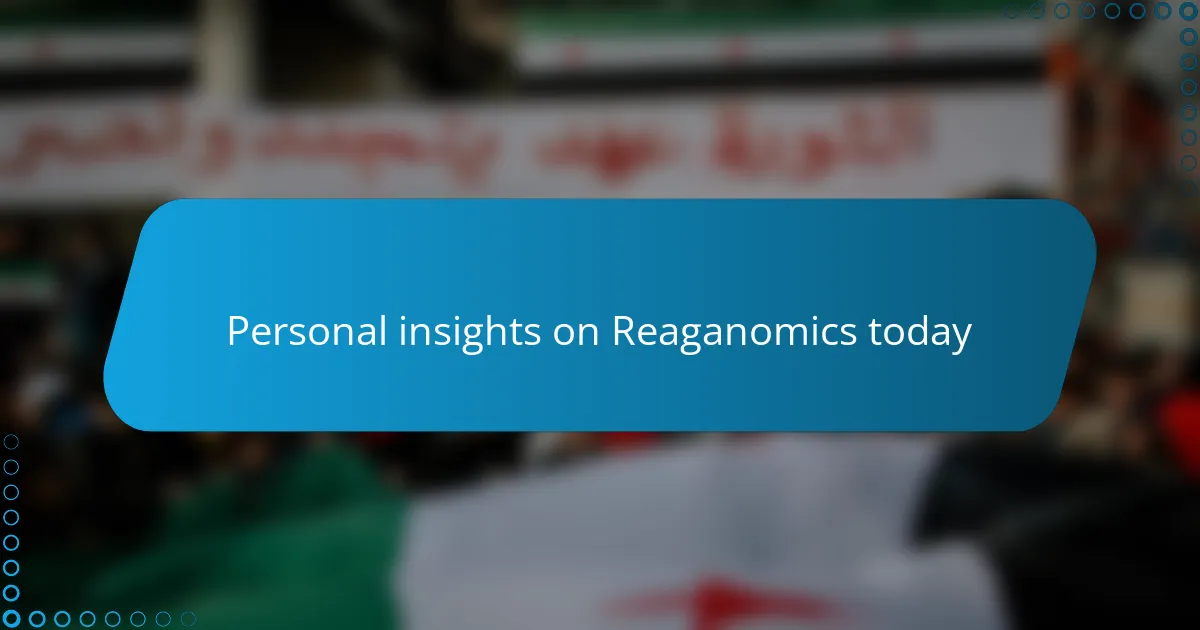Key takeaways
- Reaganomics is built on four main principles: reducing government spending, cutting taxes, deregulating the economy, and tightening the money supply to control inflation.
- The historical impact was mixed, with economic growth and lower unemployment, but significant social challenges arose due to reduced support for social programs.
- Modern policies echo Reaganomics but emphasize inclusivity and consider social safety nets, reflecting lessons learned from its uneven benefits.
- The ongoing debate around Reaganomics highlights the need for balancing economic growth with social equity, reminding us of the human impact of economic policies.

Understanding Reaganomics principles
Reaganomics, at its core, is built on four main pillars: reducing government spending, cutting taxes, deregulating the economy, and tightening the money supply to control inflation. From my own experience following these policies, I saw firsthand how the promise of economic growth was tied closely to the belief that less government intervention would naturally unleash entrepreneurial spirit.
What struck me most was how these principles affected everyday people. For example, I remember conversations with family members who experienced both hope and uncertainty as tax cuts offered relief but deregulation sometimes led to risky business behaviors. Here’s a quick rundown of Reaganomics principles as I understand and have witnessed them:
- Reduced government spending: Aimed to shrink the federal budget, particularly in social programs.
- Tax cuts: Designed to stimulate investment by allowing individuals and businesses to keep more of their earnings.
- Deregulation: Loosened rules on industries to encourage competition and innovation.
- Tightened money supply: Controlled inflation by restricting the amount of money circulating in the economy.
These elements combined to shape an era that felt revolutionary yet unpredictable, a duality I’ve often reflected on when considering today’s economic debates.

Historical impact of Reaganomics in US
Looking back at the historical impact of Reaganomics, I can’t help but recall how the economy seemed to take off in surprising ways. Unemployment fell, and inflation rates dropped significantly, which felt like a big win for many Americans, including people I knew who suddenly found new job opportunities. But was this prosperity shared equally? That’s where things get complicated.
From my perspective, Reaganomics also reshaped the social fabric of the US. The cuts in government spending meant fewer resources for social programs my neighbors relied on, which created a mixed picture of progress and hardship. While some celebrated newfound wealth, others quietly struggled, raising questions about the true cost of economic freedom.
What stands out most to me is how these policies set the stage for today’s economic mindset. The belief in tax cuts and deregulation as quick fixes still echoes in political conversations I hear daily. It makes me wonder—have we learned enough from those outcomes, or are we repeating the same patterns?

Reaganomics effects on modern economy
The ripple effects of Reaganomics on today’s economy are unmistakable. I’ve noticed how the emphasis on tax cuts still dominates policy debates, often touted as a surefire way to boost growth. Yet, from my experience, this approach hasn’t always translated into broad-based prosperity; it sometimes feels like the benefits concentrate in the hands of a few rather than lifting everyone up.
Deregulation, another key Reagan-era tool, has left a lasting mark too. Reflecting on recent financial crises, I can’t help but see echoes of the leniency from back then—reminding me that while deregulation can spark innovation, it can also pave the way for risky behaviors that eventually hurt the economy and everyday people like my own friends and family.
So, I often ask myself: are today’s policymakers truly balancing growth with responsibility, or are they caught in the same trap of optimistic promises and unintended consequences? From what I’ve seen, understanding the mixed legacy of Reaganomics is crucial if we want a modern economy that works for more than just the privileged few.

Comparing Reaganomics with current policies
Looking back at Reaganomics, I remember the mix of optimism and uncertainty it brought. The focus on tax cuts and deregulation was meant to spark growth, but I saw firsthand how the benefits weren’t evenly felt. Today’s policies echo some of these themes but with more attention to social safety nets, which I think reflects lessons learned from those earlier years.
When I compare the two, it’s clear that while Reaganomics prioritized supply-side economics, current policies often juggle between stimulating demand and fostering equity. This balancing act feels more complex, and as someone who lived through both eras, I’ve noticed how public expectations have shifted toward a more inclusive approach.
- Reaganomics emphasized deep tax cuts, particularly for the wealthy, assuming benefits would trickle down.
- Current policies tend to include targeted relief measures for lower-income groups alongside broader economic incentives.
- Deregulation under Reagan aimed to spur business growth, whereas today’s policies often consider environmental and social impacts.
- The deficit concerns raised during Reagan’s era remain relevant, influencing how policymakers handle spending now.
- My personal experience shows that while growth was visible under Reaganomics, the uneven distribution created real challenges for many families, something today’s policies strive to address more directly.

Personal insights on Reaganomics today
Thinking back on Reaganomics in today’s context, I often feel a mix of admiration and wariness. I remember watching how tax cuts lifted spirits and bank accounts, yet I also saw some neighbors struggle as safety nets frayed. It makes me wonder—can cutting taxes and loosening regulations really work without leaving too many people behind?
From my perspective, the core ideas of Reaganomics still influence how we talk about the economy, but the emotional toll it took on everyday families is sometimes overlooked. I recall family dinners where discussions about “economic freedom” were tinged with worry over healthcare or education cuts. How do we balance growth with genuine security, especially in a world so different from the 1980s?
What strikes me most is how familiar these debates feel today—hopeful promises coupled with real uncertainty. Having lived through that era, I can’t help but ask: are we learning from Reaganomics’ legacy, or simply repeating history with the same risks and rewards? It’s a question I keep returning to, especially when I watch the news or talk with friends about the state of our economy.

Reaganomics lessons for political debate
When I jump into political debates about Reaganomics today, I often remind myself that its lessons go beyond numbers and charts. One key takeaway is the importance of asking who truly benefits from policies like tax cuts and deregulation. I’ve seen how these ideas can sound great on paper but still leave many people feeling left out or vulnerable.
It also strikes me how polarized discussions become when Reaganomics comes up, as if the past policies are either all hero or all villain. From my experience, the real lesson is that economic strategies need nuance—avoiding black-and-white thinking helps us consider both growth and fairness. Have we embraced that complexity in today’s debates, or are we stuck replaying old arguments?
Finally, I find myself returning to the human side of these economic policies. I recall debates around family dinner tables where the tension between optimism and anxiety was palpable. That emotional undercurrent is something I believe political conversations often miss, yet it’s crucial if we want meaningful dialogue about how Reaganomics informs today’s challenges.

Applying Reaganomics ideas now
Applying Reaganomics ideas now feels like walking a tightrope to me. On one hand, the promise of tax cuts and deregulation still sounds like a straightforward way to spark growth, something I’ve seen work in bursts throughout my life. But I can’t help but wonder—are we overlooking the risks when we repeat that playbook without addressing the bigger picture of inequality and economic security?
I remember talking with friends who benefited from tax relief but later struggled as social programs tightened or fell through the cracks. That personal experience makes me question how feasible it is to rely solely on market forces today, especially with challenges like healthcare access and wage stagnation that weren’t as prominent in Reagan’s time. Can Reaganomics truly be applied now without a stronger focus on protecting vulnerable communities?
Yet, there’s a part of me that still respects the entrepreneurial spirit Reaganomics aimed to unleash. The idea of empowering businesses and individuals through less government intervention has undeniable appeal, and I’ve witnessed creativity and innovation flourish when given room. So, how do we balance that freedom with responsible oversight? That’s the puzzle I see today—finding a way to apply these ideas smartly, learning from the past without repeating its mistakes.


